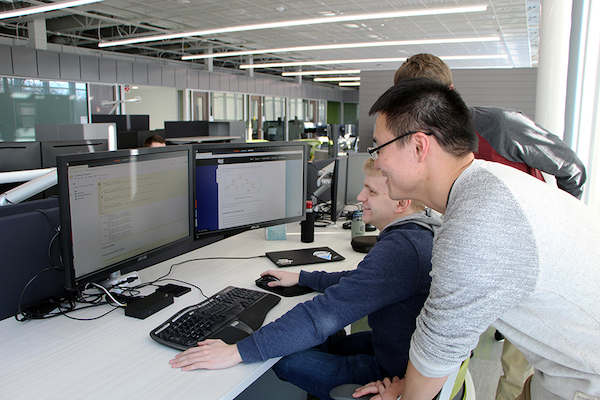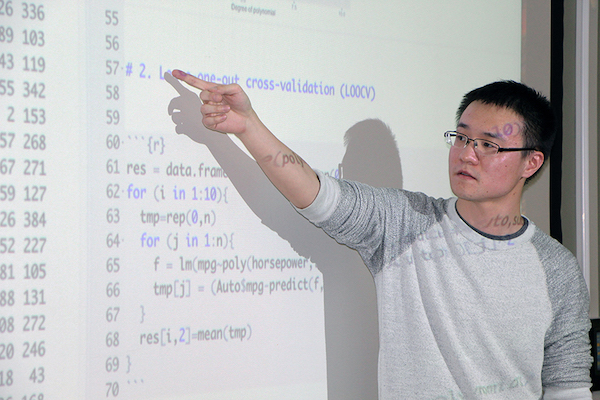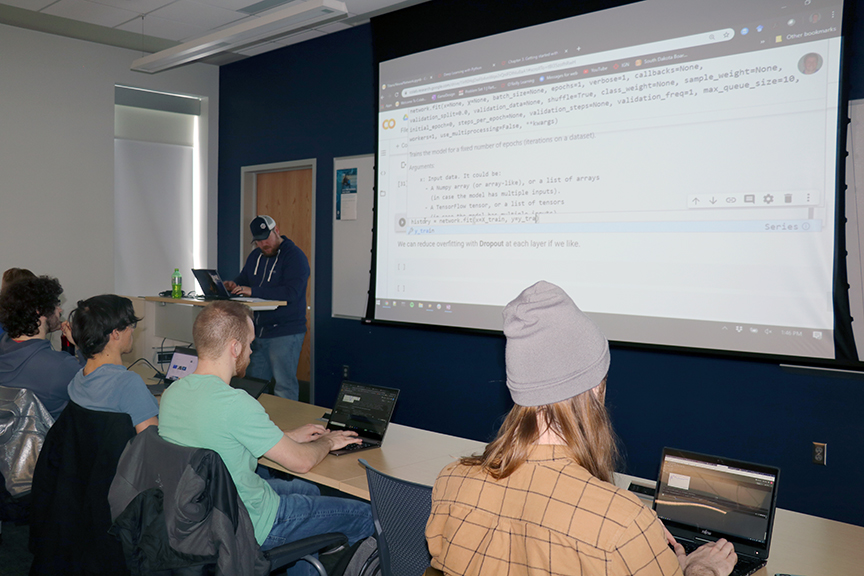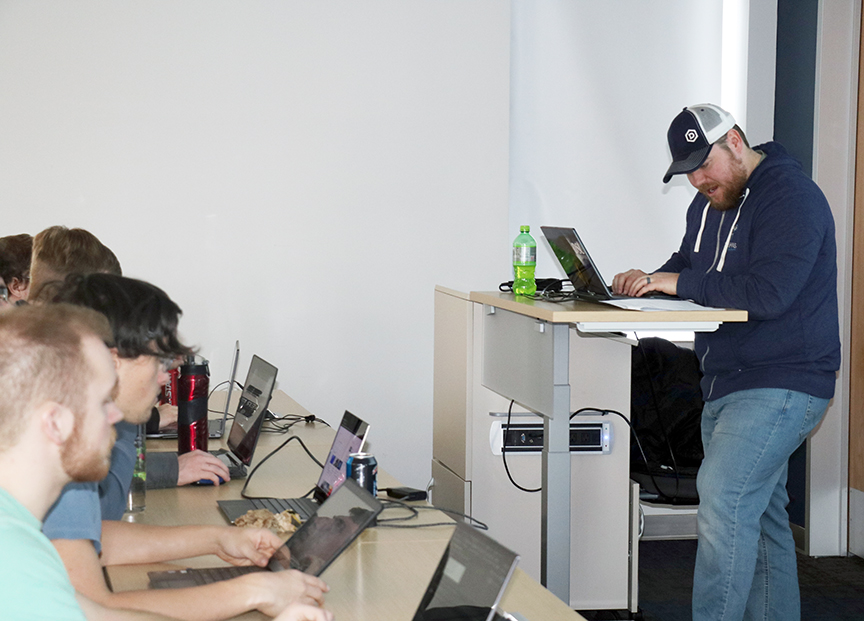Building the future with artificial intelligence, machine learning at Dakota State
Sept. 28, 2020
This paid piece is sponsored by Dakota State University.
Artificial intelligence, or AI, often conjures up images from pop culture and sci-fi of a dystopian future where humans are controlled by AI computer or robot overlords.
In reality, AI often takes the form of computer programming created to make intelligent decisions based on large amounts of data.
Dakota State University is leading the way in changing public perceptions of AI and developing new ways to utilize AI to positively benefit society.
“Artificial intelligence is the simulation of human intelligent behavior by computers,” said Dr. Shengjie Xu, DSU assistant professor of computer and cyber sciences. “AI is a very broad concept that involves a variety of subjects, including computer science, mathematics, statistics, business management, linguistics, psychology and many others.”
AI is a rapidly evolving field of study, research and application that is being used to improve national security, economic development and quality of life.
It primarily is used for making decisions, which can be utilized in a variety of situations and industries. Even a small business can use AI for tasks such as keeping inventory based on time cycles – ranging in time from years, months, weeks, days, down to the hour of the day. It can be automated to purchase new stock when inventory is low, explained Dr. Austin O’Brien, assistant professor in computer science at DSU.
Outside of business use, AI is a part of everyday life through real-world applications.
“AI is already making an impact in many people’s lives even if they don’t realize it,” said Dr. Pat Engbretson, dean of the Beacom College of Computer and Cyber Sciences at Dakota State. “Virtual assistants and smart speakers, self-driving cars, infrastructure improvements, fraud prevention and spam filters are a few specific examples.”
AI at Dakota State
Dakota State understands the importance of this rapidly growing field. Over the past three years. DSU has added AI as an emphasis in its computer and cyber sciences degree programs and most recently has added an artificial intelligence minor and is in the process of creating a major as well.
With Dakota State’s cybersecurity focus and deep foundations in computer science, the study of AI is a natural programming addition.
“We have multiple faculty in the Beacom with a significant amount of AI and machine learning expertise,” Engbretson said. “All of these points work together to make the Beacom a fit for AI.”
AI courses already in place at DSU cover a variety of topics. Students are introduced to machine learning, a subset of AI, through a fundamentals course where they learn about popular algorithms and how they can be applied to real-world situations. Machine learning requires a large amount of data that algorithms use to create a model that can be used to make predictions or classify observations, O’Brien said.
“As an example, if we wanted to write an AI program that could identify whether a picture is of a dog or a cat, we would have to show the program many labeled pictures of each type of animal in different poses, angles, sizes, obscured by other objects and so on in order for the program to get an idea of the differences between what cats and dogs are,” he explained. “Only then could it try to predict which animal is in a new unlabeled picture that we show it.”
A new AI course on reinforcement learning teaches students about software agents that “learn” through reinforcement.
“A software agent ‘learns” a decision-making policy by recognizing its environment and being rewarded for taking actions that bring it closer to achieving its goal,” O’Brien said.
Other courses focus on AI in cybersecurity at the graduate level. In the course machine learning for cybersecurity, students study the technical issues in applying AI and machine learning to solve problems in security and privacy. This includes intrusion detection, malware detection, differential privacy, blockchain and more, explained Xu. The content also covers an emerging topic called adversarial machine learning, which is about attacking and defending machine learning-enabled cyber systems.
While AI is continually evolving, improving and being applied to new areas of study, there’s still a lot of progress to be made.
“Currently, while computers can access and process data quickly, AI has a hard time extrapolating actions outside of its training cases,” O’Brien said. “When something new occurs, AI often behaves oddly and displays ‘unintelligent’ behavior.”
An example of this would be if you trained a software to play a game, it could not successfully switch to a different game with new objectives, whereas a child can fairly easily take up a new game without much training, O’Brien said. This highlights the need for continued research to make AI able to generalize in a human-like display of intelligence.
The Artificial Intelligence Lab
Dakota State is dedicated to developing this research. The Artificial Intelligence Lab in MadLabs is committed to pioneering and conducting scientific research in the field of AI, as well as applying AI to significantly address the emerging challenges in various smart applications, such as security and privacy, Internet of Things, or IoT, with 5G and edge computing.
Xu is the director of the AI Lab.
“We are working on two projects: building robust AI models to defend critical cyberinfrastructure from malicious cyberattacks and deploying AI models for resource-constrained IoT networks to improve the network performance,” he said.
The AI Lab gives students the opportunity to participate in research with six students working in the lab and three Ph.D. students conducting additional AI research.
Four peer-reviewed papers based on research from the AI Lab have been published regarding the topic of AI for cybersecurity.
O’Brien also is working on a research project with efforts to create a software program that can run a penetration test.
“A penetration test stems from the field of cybersecurity where someone is hired to find the vulnerabilities in a company’s computing system by ‘hacking’ it and then reporting any vulnerabilities found to the company and providing solutions to these problems,” he explained.
He hopes to use reinforcement learning to generalize a software program to do this type of work on different systems and also is interested in applying AI to agriculture.
With the continued study of AI, DSU will look to work with local businesses and promote entrepreneurship to use AI to help South Dakota’s economy, O’Brien said, adding he’s excited to be at DSU for the inception of these programs and looks forward to becoming the AI education hub for the region.
“Leveraging our past successes in technology and our strong computational foundations along with our faculty and cutting-edge facilities, DSU is poised to execute on the vision of becoming an AI leader,” Engbretson added.
“At DSU, AI is not just a buzzword, we have several faculty already working in the Beacom College with a significant amount of AI experience and funded research projects. This is an incredibly exciting time to jump into the field, and we are ready to help students achieve their potential.”











